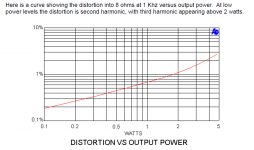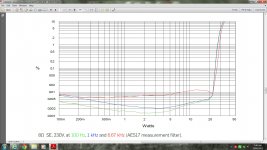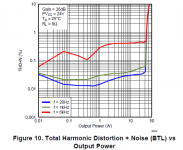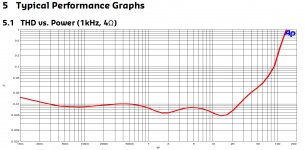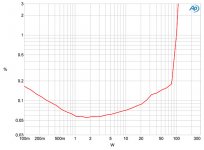 split off from here --> http://www.diyaudio.com/forums/full-range/276418-noob-noob-ideas-2.html
split off from here --> http://www.diyaudio.com/forums/full-range/276418-noob-noob-ideas-2.htmlI don't think the distortion on the ACA is actually that low - if you look at the build article its in the percent range at 5 watts whereas the 3116 is like 0.1% at 35 watts.
You mean measured distortion… those numbers tell us exactly nothing.
dave
Last edited by a moderator:
Planet10,
Ok if you don't think one of the most important measured parameters of an amp tells us nothing that is fine for you. For the rest of us, quantifiable measurement of performance means quite a bit and we make informed choices based on real things rather than opinions.
The typical 10% distortion at a given power is often used because 10% is very audible. Exceeding that value pushes the amp to sounding terrible terrible territory. If you don't think knowing where that power limit is on an amp, you have no idea where it's max rated power is as an intrinsic capability. Should one operate the ACA at 20 watts? What is the HD there? I am quite sure it is not meaningless or nothing.
Just because you don't believe in measurements of drivers or amps being useful doesn't mean you should push your opinion as if it was dogma with no facts to back it up. Show me some facts that says harmonic distortion of an amp means nothing. I think we are all interested to see that. If it wasn't important why did Nelson Pass measure it and discuss it in the ACA build guide?
Let's see what the experts in the ACA thread think of the uselessness of HD:
http://www.diyaudio.com/forums/pass-labs/215392-amp-camp-amp-aca-223.html#post4373557
Ok if you don't think one of the most important measured parameters of an amp tells us nothing that is fine for you. For the rest of us, quantifiable measurement of performance means quite a bit and we make informed choices based on real things rather than opinions.
The typical 10% distortion at a given power is often used because 10% is very audible. Exceeding that value pushes the amp to sounding terrible terrible territory. If you don't think knowing where that power limit is on an amp, you have no idea where it's max rated power is as an intrinsic capability. Should one operate the ACA at 20 watts? What is the HD there? I am quite sure it is not meaningless or nothing.
Just because you don't believe in measurements of drivers or amps being useful doesn't mean you should push your opinion as if it was dogma with no facts to back it up. Show me some facts that says harmonic distortion of an amp means nothing. I think we are all interested to see that. If it wasn't important why did Nelson Pass measure it and discuss it in the ACA build guide?
Let's see what the experts in the ACA thread think of the uselessness of HD:
http://www.diyaudio.com/forums/pass-labs/215392-amp-camp-amp-aca-223.html#post4373557
Last edited:
Ok if you don't think one of the most important measured parameters of an amp tells us nothing that is fine for you.
As soon as you collapse the HD data into a single number you lose all the relevant information. THD is useless and not important. It is an unimportant -- and even misleading -- piece of data that is still around only due to momentum. One starts to get relevant information when one looks at the HD charts.
The typical 10% distortion at a given power is often used because 10% is very audible.
To get that high you are driving the amp into heavy clipping and that is what your are hearing. How well an amplifier clips is a very important.
dave
I'm not choosing sides on this one but all my electronics schooling (cause this is what I do for a living) I'm inclined to agree with Dave on this one...
Back in the 80's when I first went to get my electronics degree...we designed a few amps...one on the parameters was exactly what Dave stated...how well it can clip and keep on ticking...that was hugely important in the design factor...
I also agree that THD is useless...it's like the way they rated watt handling\rating\output back in the day...a misleading number...has nothing to do with how an amp can sound...and I can back this up...if THD was so important...no one would run tubes...which brings me back to the other point...tubes know how to clip...and solid state guys all wish their amps would clip like that LOL!!!
It's a vicious cycle...everyone wants the tube sound at 300wpc!!
I say the first watt and better speakers is the way to go...lets work with that design parameter and everyone would be happy campers 🙂
Back in the 80's when I first went to get my electronics degree...we designed a few amps...one on the parameters was exactly what Dave stated...how well it can clip and keep on ticking...that was hugely important in the design factor...
I also agree that THD is useless...it's like the way they rated watt handling\rating\output back in the day...a misleading number...has nothing to do with how an amp can sound...and I can back this up...if THD was so important...no one would run tubes...which brings me back to the other point...tubes know how to clip...and solid state guys all wish their amps would clip like that LOL!!!
It's a vicious cycle...everyone wants the tube sound at 300wpc!!
I say the first watt and better speakers is the way to go...lets work with that design parameter and everyone would be happy campers 🙂
I agree plots showing harmonics is more useful than plain THD. However, Nelson Pass provides a plot of presumably THD for the ACA, although he calls it just plain 'Distortion' and explains in text that it is a combination of 2nd and 3rd order and at what power levels which dominate.
The Nelson Pass article on the ACA is here:
http://www.firstwatt.com/pdf/art_amp_camp_1.pdf
Excerpted from the article is the graph of distortion vs amp output power, measured and plotted by Nelson Pass himself. If you think Mr Pass does things just due to 'momentum' of a meaningless industry standard practice, and if you think that this curve is un-important or not useful - then I don't know what to say. It's the same old mentality of trying to build good sounding speakers and refusing to believe that frequency response measurements are important to the sound quality, when it is in fact, to first order, the most important thing about how a speaker sounds. I am not going to go on about this, but just want to point out that many people rely on this type of curve, and it IS important in characterizing the baseline intrinsic ability of an amp not to generate frequencies outside of what it was asked to. Simple as that. Without it, how do we compare amp performance based on spec sheets and numbers without having a unit in hand and lab to test it? If THD vs power it is outdated, take a look at the design articles and manufacturer spec sheets on amps, they are filled with pages upon pages of distortion vs power plots.

Look at the Texas Instruments data sheet for the TPA3116D2, I can count a total of 14 plots of THD vs power. Is TI wasting their engineers' time by making them generate, collect, and publish 14 THD vs power plots?
http://www.ti.com/lit/ds/symlink/tpa3116d2.pdf
One more example, the ST Microelectronics TDA7498 spec sheet has about 8 plots of THD vs power.
http://www.st.com/web/en/resource/technical/document/datasheet/CD00244535.pdf
If I did not have the THD vs power plots for the above two amps, how should I compare them while trying to specify which chip to use? Should I just listen to the golden eared test engineer who says, it sounds "great, lots of bass authority, exceptional transparency and lack of graininess,..." blah blah blah and more words of un-quantifiable superlatives.
Just saying, you need hard numbers at some point to compare. They are not useless. And just for background, I also used to do testing of electronics in a nicely equipped lab as part of my job.
The Nelson Pass article on the ACA is here:
http://www.firstwatt.com/pdf/art_amp_camp_1.pdf
Excerpted from the article is the graph of distortion vs amp output power, measured and plotted by Nelson Pass himself. If you think Mr Pass does things just due to 'momentum' of a meaningless industry standard practice, and if you think that this curve is un-important or not useful - then I don't know what to say. It's the same old mentality of trying to build good sounding speakers and refusing to believe that frequency response measurements are important to the sound quality, when it is in fact, to first order, the most important thing about how a speaker sounds. I am not going to go on about this, but just want to point out that many people rely on this type of curve, and it IS important in characterizing the baseline intrinsic ability of an amp not to generate frequencies outside of what it was asked to. Simple as that. Without it, how do we compare amp performance based on spec sheets and numbers without having a unit in hand and lab to test it? If THD vs power it is outdated, take a look at the design articles and manufacturer spec sheets on amps, they are filled with pages upon pages of distortion vs power plots.

Look at the Texas Instruments data sheet for the TPA3116D2, I can count a total of 14 plots of THD vs power. Is TI wasting their engineers' time by making them generate, collect, and publish 14 THD vs power plots?
http://www.ti.com/lit/ds/symlink/tpa3116d2.pdf
One more example, the ST Microelectronics TDA7498 spec sheet has about 8 plots of THD vs power.
http://www.st.com/web/en/resource/technical/document/datasheet/CD00244535.pdf
If I did not have the THD vs power plots for the above two amps, how should I compare them while trying to specify which chip to use? Should I just listen to the golden eared test engineer who says, it sounds "great, lots of bass authority, exceptional transparency and lack of graininess,..." blah blah blah and more words of un-quantifiable superlatives.
Just saying, you need hard numbers at some point to compare. They are not useless. And just for background, I also used to do testing of electronics in a nicely equipped lab as part of my job.
Attachments
Last edited:
Whoa...back up X...that's not what you said...
If I read a spec and it says this:
50Wx 2 4ohm 1%THD
Does that look like anything I see as compared to the chart I posted?? Absolutely not...
My point is...numbers are meaningless...sorry...they can be padded to make things look better than they appear...
Graphs...plots...charts are the only way to derive the most useful information...and in most cases...manufacturers don't like releasing that stuff to the consumer...
If I read a spec and it says this:
50Wx 2 4ohm 1%THD
Does that look like anything I see as compared to the chart I posted?? Absolutely not...
My point is...numbers are meaningless...sorry...they can be padded to make things look better than they appear...
Graphs...plots...charts are the only way to derive the most useful information...and in most cases...manufacturers don't like releasing that stuff to the consumer...
Attachments
I got to thinking X...here I think lies the issue...
The older I get and see all the young ones coming out of the gate...I have to change the way I do things for them to understand..."Lowest Common Denominator"...that's the ticket...
Speak and teach to that...not everyone that looks at a graph can understand...the marketing guys know this...hence when they advertise an amp as 200WPC 4ohms 1%THD...what you are really getting is probably a nice clean 300wpc maybe 40wpc into 8 ohms...but does that look good?? Nope!!
So where you and I may know the difference...the masses don't...lowest common denominator...
Not to mention...us old school guys know that good sound does not always equate to good specs...please respect that...
You mentioned Mr. Pass...Nelson Pass has forgotten more than we will ever know...he caters (correct me if I'm wrong) to distortion curves...one amp will embellish a second order harmonic to make things sound pleasing and warm while turning a second amp into a detail freak by working with odd harmonics...but he shares and that's the difference...he works with the DIY community...not to many designers do that today...everything's a secret!!
Just because it looks good doesn't mean that it is...or better yet...will work the way you want it to...
The older I get and see all the young ones coming out of the gate...I have to change the way I do things for them to understand..."Lowest Common Denominator"...that's the ticket...
Speak and teach to that...not everyone that looks at a graph can understand...the marketing guys know this...hence when they advertise an amp as 200WPC 4ohms 1%THD...what you are really getting is probably a nice clean 300wpc maybe 40wpc into 8 ohms...but does that look good?? Nope!!
So where you and I may know the difference...the masses don't...lowest common denominator...
Not to mention...us old school guys know that good sound does not always equate to good specs...please respect that...
You mentioned Mr. Pass...Nelson Pass has forgotten more than we will ever know...he caters (correct me if I'm wrong) to distortion curves...one amp will embellish a second order harmonic to make things sound pleasing and warm while turning a second amp into a detail freak by working with odd harmonics...but he shares and that's the difference...he works with the DIY community...not to many designers do that today...everything's a secret!!
Just because it looks good doesn't mean that it is...or better yet...will work the way you want it to...
Whoa...back up X...that's not what you said...
Here is what I said:
if you look at the build article its in the percent range at 5 watts whereas the 3116 is like 0.1% at 35 watts.
Look at the plot from the Nelson Pass article, which is where I got the "percent range at 5 watts" - consistent with what I said.
Now look at the TPA3116D2 data sheet Fig 10 which shows THD vs Power for 24v supply, 26dB gain, for 8ohm load. The average THD between 1kHz, 6kHz, and 20kHz is about 0.1% at a little above 30 watts - consistent with what I said above.
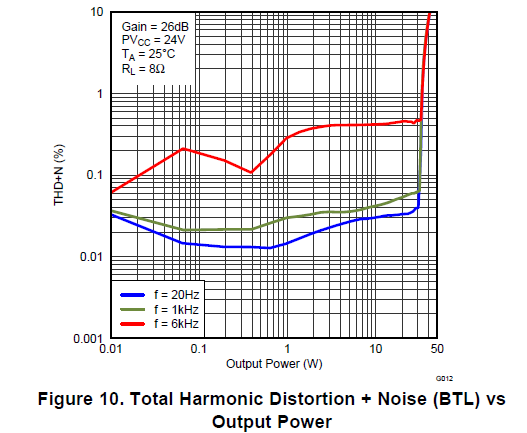
The plots are useful and manufacturers like TI and STM are certainly not hiding them.
us old school guys know that good sound does not always equate to good specs...please respect that..
I agree with you on this, and no disrespect is meant. However, some people have a knack for constantly (and many times incorrectly) challenging statements that I make which are based on quantifiable measurements, whereas theirs are based on anecdotes and opinions.
Attachments
Last edited:
X...see this chart I posted...tell me what you would give as a rating for this amp...
If I use 0.1% THD as the criterion for acceptable distortion, then the amp described by this plot is capable of delivering 90 watts into a 4 ohm load with acceptable distortion.
I know this is a trick question, because the plot says 1kHz. What are the distortion components at other frequencies?
So my caveat is that the amp "shall not have a THD that exceeds 0.1% at any frequency between 20Hz and 20kHz." If it does, then the power at which the THD at any frequency exceeds 0.1% is the power rating.
Ya...it is kinda a trick question 🙂
But it's to prove a point...
The manufacturer markets this amp as: Power output: 100Wpc into 8 ohms (20dBW), 200Wpc into 4 ohms (20dBW). THD: <0.1% typical, <1% at rated power. Frequency response: 5Hz–20kHz, ±1dB.
That's as measured by Stereophile...see the chart below: The ***** precisely met its specification of maximum power into 8 ohms: 100Wpc, or 20dBW at 1% THD+noise
Did the manufacturer lie?? Heck no...did he embellish?? Heck yes!!
You can say anything you want in the numbers but unless you have a graph they are meaningless...
This is why I never look at numbers...I'm guessing Dave is the same way...I'm not speaking for him so I could very well be wrong...my apologies if I am...
I'm saying that in my many years numbers mean squat...and the lower common denominator dictates that...
We find ourselves fortunate to be in the DIY community where we can gather the specific information we need...others are not so fortunate and take for granted that they are being fed the truth when in actuality they are being fed half truths...
This model we are in needs to be respected or someday we may find ourselves as the lowest common denominator...
But it's to prove a point...
The manufacturer markets this amp as: Power output: 100Wpc into 8 ohms (20dBW), 200Wpc into 4 ohms (20dBW). THD: <0.1% typical, <1% at rated power. Frequency response: 5Hz–20kHz, ±1dB.
That's as measured by Stereophile...see the chart below: The ***** precisely met its specification of maximum power into 8 ohms: 100Wpc, or 20dBW at 1% THD+noise
Did the manufacturer lie?? Heck no...did he embellish?? Heck yes!!
You can say anything you want in the numbers but unless you have a graph they are meaningless...
This is why I never look at numbers...I'm guessing Dave is the same way...I'm not speaking for him so I could very well be wrong...my apologies if I am...
I'm saying that in my many years numbers mean squat...and the lower common denominator dictates that...
We find ourselves fortunate to be in the DIY community where we can gather the specific information we need...others are not so fortunate and take for granted that they are being fed the truth when in actuality they are being fed half truths...
This model we are in needs to be respected or someday we may find ourselves as the lowest common denominator...
Attachments
Interesting discussion. I'm still learning how to read these kinds of things, but the kind of misleading advertising/marketing that you're talking about happens everywhere.I got to thinking X...here I think lies the issue...
The older I get and see all the young ones coming out of the gate...I have to change the way I do things for them to understand..."Lowest Common Denominator"...that's the ticket...
Speak and teach to that...not everyone that looks at a graph can understand...the marketing guys know this...hence when they advertise an amp as 200WPC 4ohms 1%THD...what you are really getting is probably a nice clean 300wpc maybe 40wpc into 8 ohms...but does that look good?? Nope!!
So where you and I may know the difference...the masses don't...lowest common denominator...
Not to mention...us old school guys know that good sound does not always equate to good specs...please respect that...
You mentioned Mr. Pass...Nelson Pass has forgotten more than we will ever know...he caters (correct me if I'm wrong) to distortion curves...one amp will embellish a second order harmonic to make things sound pleasing and warm while turning a second amp into a detail freak by working with odd harmonics...but he shares and that's the difference...he works with the DIY community...not to many designers do that today...everything's a secret!!
Just because it looks good doesn't mean that it is...or better yet...will work the way you want it to...
"More Dentists recommend..."
"Made with natural ingredients..."
"Made with real fruit juice..."
and so on...
Learning to read these things with a critical eye is important if you want to get what you are hoping or expecting.
As someone who is still learning to read manufacturer's stats with a critical eye (I'm still not very proficient at it, but am trying), can I assume you meant to say 30wpc and not "300wpc" above? If not then I am really confused. 😱
I see more and more of these "distorted" numbers\specs these days with the increasing use of digital amps...
Ya...it is kinda a trick question 🙂
But it's to prove a point...
The manufacturer markets this amp as: Power output: 100Wpc into 8 ohms (20dBW), 200Wpc into 4 ohms (20dBW). THD: <0.1% typical, <1% at rated power. Frequency response: 5Hz–20kHz, ±1dB.
That's as measured by Stereophile...see the chart below: The ***** precisely met its specification of maximum power into 8 ohms: 100Wpc, or 20dBW at 1% THD+noise
Did the manufacturer lie?? Heck no...did he embellish?? Heck yes!!
You can say anything you want in the numbers but unless you have a graph they are meaningless...
This is why I never look at numbers...I'm guessing Dave is the same way...I'm not speaking for him so I could very well be wrong...my apologies if I am...
I'm saying that in my many years numbers mean squat...and the lower common denominator dictates that...
We find ourselves fortunate to be in the DIY community where we can gather the specific information we need...others are not so fortunate and take for granted that they are being fed the truth when in actuality they are being fed half truths...
This model we are in needs to be respected or someday we may find ourselves as the lowest common denominator...
With this plot, I would say that the power rating is <80 watts otherwise you hit the cliff and who knows what the distortion is for an almost infinite slope. But you are saying this curve did not come from manufacturer, but from 3rd party Stereophile test which revealed that 100w is embellishing because you are on the ledge?
You can say anything you want in the numbers but unless you have a graph they are meaningless...
Not if they are small enough. Referencing units with 1% distortion and higher is where I see that fault.
Not if they are small enough. Referencing units with 1% distortion and higher is where I see that fault.
The fault is in the consumer whereas we are ignorant to such specs and the marketing units of audio companies will prey on that knowledge...
This is nothing new...dates back decades...
Until such standards are put into place...I have to say for the most part...IMO...that numbers are useless unless backed by true measurements and graphs...going on numbers alone is naïve...
Don't get me wrong, I agree for the most part that distilling the "goodness" of a unit down to a single number is wrong.
When people say distortion is below 2% at rated power throughout the audible band, I lose interest, as it says nothing about when the unit might near 2% distortion.
If they say distortion is below 0.01% at rated power throughout the audible band, I am very interested in learning more.
So, to me, those numbers are not entirely useless.
Edit: I have done measurements at home, and yes, distortion can vary greatly with frequency -- HF distortion is worse, which is why I insist that the statement "throughout the audible band" or something similar is present. It does not matter much what the distortion is a 1KHz, if the distortion at 12KHz is 50 times greater.....
When people say distortion is below 2% at rated power throughout the audible band, I lose interest, as it says nothing about when the unit might near 2% distortion.
If they say distortion is below 0.01% at rated power throughout the audible band, I am very interested in learning more.
So, to me, those numbers are not entirely useless.
Edit: I have done measurements at home, and yes, distortion can vary greatly with frequency -- HF distortion is worse, which is why I insist that the statement "throughout the audible band" or something similar is present. It does not matter much what the distortion is a 1KHz, if the distortion at 12KHz is 50 times greater.....
Last edited:
If they say distortion is below 0.01% at rated power throughout the audible band, I am very interested in learning more….
I 1st got a footing on the reality of the usefullness of THD in the late 70s… and largerly because published numbers were way too small… 0.0000x kinda thing. These amps used excessive feedback to get vanishingly low numbers and sounded crap.
As soon as you collapse the various harmonics in an HD graph onto a single number -- or rven a single curve -- you loose all of the relevant information, the result is useless at telling how good or bad the amplifier is.
And as Ed says, it is the 1st watt that is important (to paraphrase Pass), and this is rarely shown.
Passes mix of 2nd & 3rd is only a but useful to designer but tells us consumers nothing and says nothing about how the amp sounds. The mix, the ratio of 2nd & 3rd us very important and how much higher level harmonic crap there is VERY important. A 1% THD amp with only a nice mix of 2nd & 3rd order distortion will often sound better than a 0.01% amp that has a significant amount of higher order harmonics in it.
dave
- Status
- Not open for further replies.
- Home
- General Interest
- Everything Else
- THD is meaningless, the harmonic data is what matters
